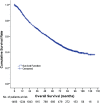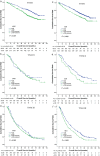Elevated pretreatment neutrophil/white blood cell ratio and monocyte/lymphocyte ratio predict poor survival in patients with curatively resected non-small cell lung cancer: Results from a large cohort
- PMID: 28544400
- PMCID: PMC5494473
- DOI: 10.1111/1759-7714.12454
Elevated pretreatment neutrophil/white blood cell ratio and monocyte/lymphocyte ratio predict poor survival in patients with curatively resected non-small cell lung cancer: Results from a large cohort
Abstract
Background: The prognostic values of preoperative neutrophil/lymphocyte ratio (NLR), monocyte/lymphocyte ratio (MLR), and platelet/lymphocyte ratio (PLR) in non-small cell lung cancer (NSCLC) have been previously described. This study assessed the prognostic values of other pretreatment complete blood cell parameters in Chinese patients with curatively resected NSCLC.
Methods: A total of 1466 consecutive NSCLC patients who received curative surgery from January 1, 2005 to December 31, 2009 with complete data from pretreatment blood tests were enrolled in this retrospective study. Correlations between each blood test parameter and overall survival were examined by Kaplan-Meier method or Cox proportional hazards regression, followed by a stratification analysis of significant variables.
Results: Optimal cut-off values of 0.55 for neutrophil/white blood cell ratio (NWR), 0.28 for lymphocyte/white blood cell ratio (LWR), 0.09 for monocyte/white blood cell ratio (MWR), 2.06 for NLR, 0.35 for MLR, 204.00 for PLR, and 38.25 for platelet/white blood cell ratio (PWR) were identified using X-tile software. Univariate analysis suggested that NWR ≥ 0.55, LWR < 0.28, MWR ≥ 0.09, NLR ≥ 2.06, MLR ≥ 0.35, and PLR ≥ 204.00 predicted a poor prognosis in NSCLC patients. However, only NWR and MLR were identified as independent significant prognostic factors in multivariable analysis, especially in tumor node metastasis stage I and I/II/III NSCLCs.
Conclusion: Pretreatment NWR, MWR, LWR, NLR, MLR, and PLR values are associated with poor overall survival for patients with curatively resected NSCLC. NWR and MLR are independent prognostic factors in curatively resected NSCLC.
Keywords: Blood test; non-small cell lung cancer; prognosis; survival.
© 2017 The Authors. Thoracic Cancer published by China Lung Oncology Group and John Wiley & Sons Australia, Ltd.
Figures





Similar articles
-
Blood cell parameters as prognostic predictors of disease development for patients with advanced non-small cell lung cancer.Oncol Lett. 2020 Aug;20(2):1101-1110. doi: 10.3892/ol.2020.11655. Epub 2020 May 21. Oncol Lett. 2020. PMID: 32724349 Free PMC article.
-
Low lymphocyte-to-white blood cell ratio and high monocyte-to-white blood cell ratio predict poor prognosis in gastric cancer.Oncotarget. 2017 Jan 17;8(3):5281-5291. doi: 10.18632/oncotarget.14136. Oncotarget. 2017. PMID: 28029656 Free PMC article.
-
Neutrophil-to-Lymphocyte ratio (NLR) and Platelet-to-Lymphocyte ratio (PLR) as prognostic markers in patients with non-small cell lung cancer (NSCLC) treated with nivolumab.Lung Cancer. 2017 Sep;111:176-181. doi: 10.1016/j.lungcan.2017.07.024. Epub 2017 Jul 24. Lung Cancer. 2017. PMID: 28838390
-
The time-series behavior of neutrophil-to-lymphocyte ratio is useful as a predictive marker in non-small cell lung cancer.PLoS One. 2018 Feb 15;13(2):e0193018. doi: 10.1371/journal.pone.0193018. eCollection 2018. PLoS One. 2018. PMID: 29447258 Free PMC article. Review.
-
Low lymphocyte count and high monocyte count predicts poor prognosis of gastric cancer.BMC Gastroenterol. 2018 Oct 11;18(1):148. doi: 10.1186/s12876-018-0877-9. BMC Gastroenterol. 2018. PMID: 30305076 Free PMC article. Review.
Cited by
-
Nonlethal Plasmodium yoelii Infection Drives Complex Patterns of Th2-Type Host Immunity and Mast Cell-Dependent Bacteremia.Infect Immun. 2020 Nov 16;88(12):e00427-20. doi: 10.1128/IAI.00427-20. Print 2020 Nov 16. Infect Immun. 2020. PMID: 32958528 Free PMC article.
-
Prognostic role of platelet to lymphocyte ratio in pancreatic cancers: A meta-analysis including 3028 patients.Medicine (Baltimore). 2018 Feb;97(8):e9616. doi: 10.1097/MD.0000000000009616. Medicine (Baltimore). 2018. PMID: 29465553 Free PMC article. Review.
-
Prognostic Value of Inflammatory Biomarkers in Patients With Stage I Lung Adenocarcinoma Treated With Surgical Dissection.Front Oncol. 2021 Sep 1;11:711206. doi: 10.3389/fonc.2021.711206. eCollection 2021. Front Oncol. 2021. PMID: 34540678 Free PMC article.
-
The Ratio of Preoperative Serum Biomarkers Predicts Prognosis in Patients With Oral Squamous Cell Carcinoma.Front Oncol. 2021 Sep 6;11:719513. doi: 10.3389/fonc.2021.719513. eCollection 2021. Front Oncol. 2021. PMID: 34552873 Free PMC article.
-
The relationship between blood biomarkers and prognosis of pathologic stage IA pure-solid non-small cell lung cancer patients.J Thorac Dis. 2025 May 30;17(5):2967-2979. doi: 10.21037/jtd-2024-2098. Epub 2025 May 28. J Thorac Dis. 2025. PMID: 40529775 Free PMC article.
References
-
- Chen W, Zheng R, Baade PD et al. Cancer statistics in China, 2015. CA Cancer J Clin 2016; 66: 115–32. - PubMed
-
- Li N, Xu M, Cai MY et al. Elevated serum bilirubin levels are associated with improved survival in patients with curatively resected non‐small‐cell lung cancer. Cancer Epidemiol 2015; 39: 763–8. - PubMed
-
- Templeton AJ, McNamara MG, Seruga B et al. Prognostic role of neutrophil‐to‐lymphocyte ratio in solid tumors: A systematic review and meta‐analysis. J Natl Cancer Inst 2014; 106: dju124. - PubMed
MeSH terms
LinkOut - more resources
Full Text Sources
Other Literature Sources
Medical

